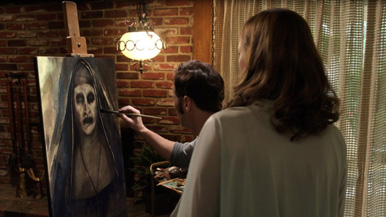|
|
Movie Review: The Conjuring 2By Ben GruchowJune 23, 2016
That a movie in what is ostensibly the “boo!” subgenre deserves a spot in a discussion about dramatic truth speaks volumes, and one needs only look at the way the world here is visualized to find evidence of that. The screenplay has some weak spots, to be sure (Janet is fine as a character, but at a certain point the movie seems to run out of things to do with the other three children). The cast is uniformly effective. O’Connor’s Peggy wears an expression of perpetual weariness and exhaustion on top of which other emotions intermingle and register. Wolfe achieves something similar, giving one performance with dialogue and quite another with facial expression. Best in show, rather expectedly, is Lorraine. Farmiga is a tremendously magnetic and evocative performer; in a film taking place mostly in rainy exteriors and chilly, shadowy interiors, she radiates necessary gravity and warmth. All of this is without even mentioning the film is terrifying. Wan largely reuses his same aesthetic from the first film: long, gliding takes and camera movements, situating activity in the corners of the frame where we don’t usually look, playing with framing to suggest much more than explicitly show, and what I interpret as a pervasive fear of wrinkled, aged faces. The Conjuring 2 is Wan at the top of his game, and there are a few sequences here where he’s basically showing off just how good he knows he is at this stuff (my favorite is a prolonged conversation where one of the participants is in the background and out of focus for the duration) but there are a lot of moments that are frightening on the pure strength of their setup and Wan’s impeccable sense of timing. There are jump scares, to be sure - the type that still tend to hold up on second viewing, because they use sinister imagery on top of being unexpected - but there are also instances of dreamlike terror and mounting dread that are exquisite in their effectiveness. The opening Amityville sequence contains more tension and disturbing imagery in a couple of minutes than the actual Amityville Horror franchise has over the course of a half-dozen films. And in a franchise that seems to have an affinity for imbuing classical childhood toys with menace, this movie picks an ace, using the staccato nature of a zoetrope to truly unnerving effect. Of course, the movie is heavily fictionalized on the basis of events and individuals; of course it doesn’t seriously challenge the Warrens as paranormal investigators. I don’t care. Its purpose is to make us feel for the people in this house and to extract an emotional reaction from us on the basis of its visuals and sound, and on the implications of its events, and this it does wonderfully. “It’s not what a movie is about, it’s how it is about it,” as Roger Ebert was quoted, and The Conjuring 2 is a superb example of its craft.
|

|
|
|

|
Friday, November 1, 2024
© 2024 Box Office Prophets, a division of One Of Us, Inc.


